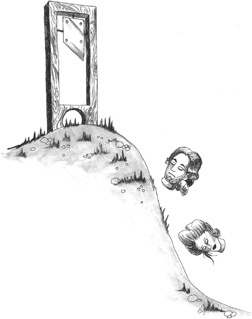
JACK and Jill went up the hill
To fetch a pail of water;
Jack fell down and broke his crown,
And Jill came tumbling after.
Up Jack got and down he trot,
As fast as he could caper;
He went to bed and covered his head
With vinegar and brown paper.
This has been traditionally seen as pure nonsense verse, and indeed, taken at face value, the rhyme doesn’t make sense. Why do Jack and Jill go up the hill to fetch water? We don’t see many wells or springs on top of a hill, do we? Water generally runs downhill, hence the bottom of a hill or a valley is the best place to look for it. There must be more to this rhyme than first meets the eye.
One popular suggestion for its origin is that Louis XVI of France and his queen, the infamous Marie Antoinette, are Jack and Jill. But the only real supporting evidence for that

is the idea that Jack broke (or lost) his crown and that Jill came tumbling after him, or at least her head did. The executions of the French royal family took place in 1793, and the poem was first published in 1795, so this interpretation does at first seem plausible.
Closer to home (and probably to reality), a small village in Somerset has laid claim to the origin of the rhyme. The story told in Kilmersdon is that during 1697 the village was home to a young unmarried couple who did a lot of their courting up on a hill, away from the prying eyes of the local gossips. Consequently Jill became pregnant, but just before the baby was born Jack was killed by a rock that fell off the hill and landed on his head. Only days later, Jill also died in childbirth. It’s cheery stuff. The nursery rhyme is these days depicted on a series of tablet stones along the path to the hill, the people of Kilmersdon being convinced of their association with the famous nursery rhyme.
For the third theory, we must travel back a further fifty years in history, and from love to alcohol. Some researchers believe King Charles I (1600-49), who, during his reign, attempted to reform taxes on alcohol, provided the real inspiration for the rhyme. It is claimed that he was prevented from raising taxes by Parliament on several occasions and so, instead, he reduced the actual measures alcohol could be served in. Up until that point, wines and ales could be bought as a pint, a half pint, known as a ‘Jack’, or a quarter pint, known as a ‘Gill’ (pronounced in the same way as the ‘gill’ of a fish) – hence Jill. As the measures came tumbling down, Charles had effectively gained his tax increase, as slightly less alcohol could then be bought for the same price. To this day, many beer glass manufacturers still mark a half-pint line on a pint glass with a crown to honour the day the Jack was decreased in volume by King Charles I. No wonder they cut his head off.
But in fact, Jack and Jill were written about even earlier, in 1595 to be precise, by William Shakespeare in A Midsummer Night’s Dream: ‘Jack shall have Jill; / Nought shall go ill.’ It sounds as if Jack and Jill may well have been used in the past as a generic name for a couple, just as we’d say Janet and John today. But, this couple go even further back in history, it would appear, research taking us to twelfth-century Iceland.
Snorri Sturluson (1178-1241) was a politician, poet and noted historian. He was also the author of a collection of Old Norse poems, myths and tales. His Gylfaginning manuscript (‘The Fooling of Gylfi’) tells the famous ancient Norse tale of a young brother and sister, Hjuki (pronounced Juk-ee) and Bil, whom the moon god captured on a dark night as they stole a pail of water from the Bygrir Well. They were immediately spirited away to the moon, where they can be seen to this day carrying a bucket of water attached to a long pole. For nearly a thousand years, Scandinavians explained the markings of the lunar surface thus, just as we in England spoke to our own children about the man in the moon or how it was made of cheese. This tale is thought by many to be the original version of ‘Jack and Jill’ (see also The Man in the Moon).